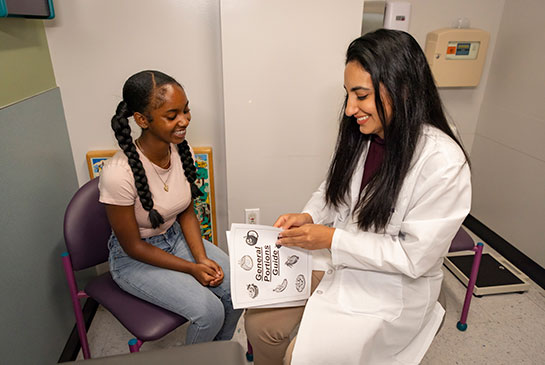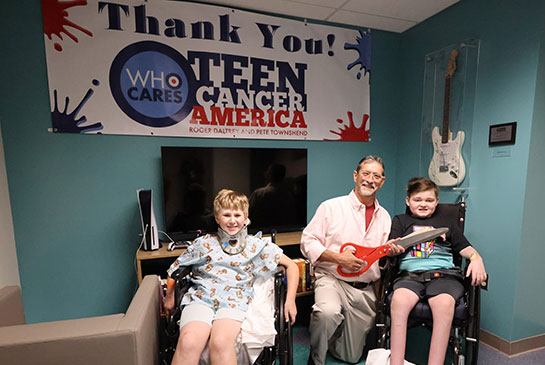Health Care Transition
Transition Support
Social Workers in the UC Davis Outpatient Pediatric Clinic
The outpatient pediatric social work team provides support to subspecialties along with the primary and urgent care clinics. The members of the social work team are available to help patients and families cope with the many psychological and social challenges that may arise during illness, post-hospitalization and medical treatment.
The social workers are patient advocates, helping to find resources and solve problems. Any concerns related to the psychological, practical or social well-being of patients and their family members or caretakers may be discussed openly with our social workers.
The range of services our social work team provides includes the following:
- Answering questions related to health insurance, Medi-Cal, Medicare, California Children's Services, Social Security and State Disability
- Supportive and adjustment counseling, including coping with chronic illness
- Assistance with transitioning from pediatric to adult care
- Education and career consultative services
- Community resource referrals
- Coordination of care to ensure adolescents, young adults and families can access treatment
- Referrals to support groups for patients and their loved ones
- Psychosocial evaluations and treatment planning
- Abuse assessment and reporting
- Crisis intervention
Adolescence is a period during which preteens and teenagers go through emotional, social, cognitive, and physical changes to prepare for adulthood. Puberty is the term used to describe these changes. Adolescence and puberty can be challenging as many teens may feel unsure or uncomfortable with these changes. Puberty is driven by hormones, which are produced by the ovaries and the testes. These changes typically occur over a few years. However, the timing of puberty can vary based on genetics and environment.
During puberty, increases in ovarian hormones drive developmental changes that include growing taller, hair growth in the genital area, body and underarm, the development of breasts, and the start of menses. These changes generally occur between the ages of 9 and 12. Increases in testicular hormones result in individuals growing taller, increasing hair growth in the genital area, body and underarm, voice changes, and the development of more muscles. These changes generally occur between the ages of 10 and 13. Acne, mood swings and shifts in body odor are other changes that you should expect during puberty.
It is not typical for puberty to begin before age 8 in people with ovarian hormones or before age 9 in people with testicular hormones. If people with ovarian hormones have not shown the initial signs of puberty (such as breast development) by age 12, or if people with testicular hormones have not shown any signs of puberty (such as testicle enlargement) by age 14, they should contact their medical provider.
The medical term for periods is menstruation. People with a uterus start bleeding from the vagina periodically during puberty. During each menstrual cycle, hormones cause the thickening of the uterine wall and the release of an egg, a process called ovulation. If there is no sperm to fertilize the egg and cause pregnancy, the uterine lining sheds, resulting in menstruation.
People with a uterus and ovaries often have their first period about two years after breast development, sometimes as early as age 9. People who are expecting a menstrual cycle, and who have not yet had their period by age 18 years old, should contact a medical provider.
Everyone’s menstrual cycle pattern is different. Menstrual cycles can be irregular for up to two years after the first period. It is important to understand the characteristics of a normal cycle:
- Frequency: Every 21 to 35 days. Remember, it doesn’t have to happen on the same day every month
- Duration: 7 days or less
- Volume: It should not interfere with daily activities, school, social life, or quality of life. Please contact a medical provider if you are soaking through a pad every 1-2 hours or passing large clots of blood
- Cramping: It should not interfere with daily activities, school, social life, or quality of life
- No bleeding between periods
Other symptoms during menstruation can include feeling tired, acne, headaches, mood changes, nausea, bloating, diarrhea and changes in appetite. If your menstrual cycles are not normal based on the characteristics above, or if you skip periods for three months or more, please talk to your medical provider about evaluation and treatment with hormonal medications.
It is important to understand how to establish healthy habits during sexual interactions. Consent must be given and received before engaging in any type of sexual activity. If a person is drunk or asleep, they cannot give consent. Additionally, anyone can change their mind at any time.
For adolescents who decide to prevent pregnancy, various contraceptive methods are available based on their goals and preferences. These methods include male condoms, the Depo-Provera injection, pills, patches, the ring, intrauterine devices or IUDs, and Nexplanon. In addition to these methods, the Copper IUD and emergency contraceptive pills are available to prevent pregnancy within a limited window of time after sexual intercourse.
Check out more information about female sexual and reproductive health.
Check out more information about male sexual health and reproductive hygiene.
For more information, check out Bedsider.
These infections can be transmitted through oral, vaginal, and anal sex. The most common STIs include chlamydia, gonorrhea, mycoplasma genitalium, genital herpes, genital warts, hepatitis B, syphilis, trichomoniasis, and human immunodeficiency virus (HIV).
STIs are very common, particularly among people aged 25 years and younger. Most people with STIs do not show any visual symptoms. When symptoms are present, they commonly include genital itching, discharge, burning, sores, intermittent vaginal bleeding, pain during sex or burning with urination. Providers can diagnose these infections through urine and blood tests.
The Centers for Disease Control and Prevention recommends annual or more frequent STI testing based on your sexual lifestyle. The most effective way to prevent STIs is by using condoms every time you have sex. Doxycycline as Post-exposure Prophylaxis (DoxyPEP) can prevent bacterial STIs if you have had sex without a condom. Pre-exposure prophylaxis (PrEP) is also available to prevent HIV. Please talk to a medical provider about STI screening, DoxyPEP, and PrEP.
Mood changes are common and expected in teens going through puberty due to the emotional, physical, and social transitions from adolescence to adulthood. Mental health disorders are characterized by persistent mood changes, anxiety, and depression that negatively affect quality of life. The most common mental health disorders in teens are depression, anxiety, attention-deficit/hyperactivity disorder (ADHD), and substance use disorder, such as alcohol or marijuana.
Common warning signs include low energy, lack of motivation, loss of interest in hobbies, feelings of guilt, panic attacks, and constant worrying. Teenagers with mental health disorders are at a higher risk of suicidal ideation and attempts. Research shows that early intervention with psychotherapy and antidepressant or antianxiety medications leads to better outcomes.
During adolescence, teenagers may experiment with different substances. Experimentation can lead to persistent use and dependence, which is defined as substance use disorder. Teens with mental health disorders are at a higher risk of developing substance use disorders. It can be dangerous for one’s health and mentally challenging to quit using substances without help of a medical provider and psychotherapist.
Individuals experiencing signs of mental health disorders should talk to their medical provider.
Eating disorders and disordered eating are common among adolescents, including anorexia nervosa, bulimia nervosa, avoidant restrictive food intake, and others. Genetics, environment and other psychosocial factors contribute to the cause of eating disorders. Teens are particularly at high risk of developing an eating disorder due to body image issues and low self-confidence during this period.
Individuals with eating disorders often do not like their bodies, worry about gaining weight, control the types and portions of food they eat, and may use other methods to lose weight, such as excessive exercise, self-induced vomiting, or taking laxatives. These behaviors can result in malnutrition or nutritional imbalances, affecting their physical health. It's important to remember that teens with eating disorders are not always thin.
Eating disorder treatment typically involves a team of health care providers, including a medical provider, dietitian, and therapist. If you exhibit any of these behaviors or are concerned about having an eating disorder, please talk to a medical provider or counselor.
Young Women’s Health
An award-winning health website for young women and members of gender minorities around the world.
Amaze
Amaze takes the awkward out of growing up. Fun, animated videos empowering healthy relationships worldwide, with all the answers you want to know about your body.




